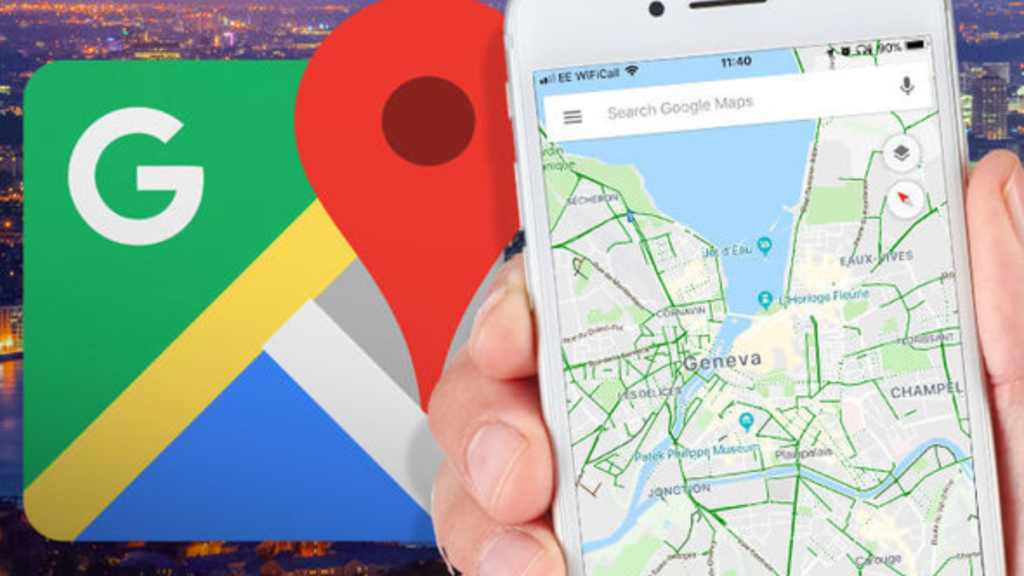More and more people are using Google Maps to get important details about their favorite local businesses.
Google Maps has over 1 billion monthly active users, making it the most popular navigation app in the United States!
Google Maps not only changed how reviews are presented but might also impact how you use your Google Business Profile.
For example, when you look up “bakeries near me,” the marker will show the ratings of all the nearby bakeries that have signed up to be on Google Maps.
Just like this:
Now, let’s see why it’s important to have company reviews and how you can edit your Google company profile to make sure your reviews show up on Google Maps:
How Do You Make Google Business Profile Display Reviews?
After you’ve verified your Google Business Profile (used to be Google My Business), you can add your business location, and your reviews will show up on Google Maps.
Now, let me guide you through the process of confirming your business on Google Maps:
- Make sure you’re logged into your Google Account.
- Open Google Maps on your laptop, iPhone, or Android device.
- Enter your company name in the search bar.
- Pick your business’s name from the results.
- Click on either “claim this business” or “manage now”.
- If you need to choose a different business, click “I own or manage another business”.
- Pick a verification option and follow the instructions on the screen.
Adding your business is easy. Just follow these three steps:
- Type your address in the search bar. Then, on the left side, find “Business Profile” and click “Add Your Business.”
- Simply tap or right-click the map’s top left corner. Next, click on “Add your business.”
- At the end of the menu, choose “Add your business.”
It’s really important to complete all the details Google asks for about your company.
Just a quick reminder, when people in your area look up your business on the Google Maps app, they’ll see ratings right next to the location marker.
Does Google Reviews on Google Maps Affect Local SEO?
The simple answer is “yes.” Google reviews can help boost search rankings.
According to Google, “Good-quality, positive reviews from your customers can make your business more visible and increase the chance that a shopper will check out your location.”
While many factors affect search rankings, online customer reviews can strongly indicate to search engines that your website is trustworthy and authoritative.
Since local searches make up 22.6% of internet traffic, there are numerous chances for your local audience to discover your business when searching for nearby brands.
In fact, 94% of consumers believe a negative review has led them to steer clear of a company.
So, responding to your customers’ comments is a great way to start a friendly chat about your company.
Good reviews on your Google Business Profile can boost your SEO too.
Moz has pointed out that engaging with online reviews is a chance for social media PR that could impact how your business shows up in search results.
Here are a few easy ways to ask for a Google business review:
- Keep it easy by sharing a link.
- Make your message personal, but keep it short.
- Ask your customer to leave a review after they’ve made a purchase.
- Talk about it on social media.
- Include your review link in your weekly emails.
Considering how this update can benefit you as a business owner and draw in new customers, it’s a good idea to ask your existing customers to share positive reviews if they enjoyed your service.
How to Reply to a Google Maps Review
As a business owner, you can’t change or remove a review, but your customer has the power to do so if they want.
When a customer has a not-so-great experience but gets a quick and helpful response from your customer care team, they’re more likely to change their review to a positive one.
To reply to a review, follow these simple steps:
First, make sure your Google Business profile is verified. If you haven’t done this yet, check out the steps here.
On your computer, open the Google Maps app.
- You can reply to reviews on Google Search and the Google Maps app.
- In Google Maps, click on your Account Circle and then Your Business Profile.
- If you’re using Google Search, just type your company name in the search bar.
- Click on Reviews.
- You’ll see all the reviews and star ratings in chronological order.
- Pick the review you want to respond to and type in your reply.
- Click on Reply.
Unfavorable reviews might bring down your star rating, but you can turn them into a positive by responding promptly to the customer.
Pay attention to their not-so-good experience, but keep your response focused on addressing the problem rather than making it personal or about the customer.
If the issue can be sorted out through email or a phone call, share your contact details in the response and help the customer resolve the problem. According to Google, it’s also a good idea to sign off with your name or initials to add credibility to your response.
An updated review will show potential customers that your company values their experiences and is committed to making improvements, even after a not-so-great experience.
A fast heads-up: Your replies might not show up on Google immediately.
But here’s the bright side – once you reply to a review, the person reviewing it gets a heads-up. They can update it right after reading what you wrote.
Rules for Google reviews
Customers who share ratings and reviews need to follow Google’s rules for content and reviews.
Reviews that break the rules, like inappropriate content or spam, might be taken off their page and won’t be put back.
Remember, Google doesn’t permit reviews from anonymous users, so your information will be made public.
How Often Does Google Maps Update?
Google Maps updates typically prioritize areas with higher populations, ensuring they receive more frequent updates. According to Google Maps’ Technical Program Manager Matt Manolides in a Maps 101 blog, “Overall, our goal is to keep densely populated places refreshed on a regular basis.”
In simpler terms, while places like New York City may see updates weekly, the remote forests of northern Maine might not get any for years.
Yet, it’s surprising how much influence individual users wield over the maps in their own areas.
Street View
Street View is perhaps the most famous feature of Google Maps, letting users explore genuine on-the-ground images of almost anywhere in the United States and beyond. Google says updating it is quite a complex task.
Typically, Google tries to snap new Street View photos in major cities annually. But if you’re in less densely populated areas, you might see fresh images every three years or even longer.
Even though it’s not talked about much, the Street View team does have a public list of places they plan to visit in many countries worldwide. You can find this list on their website under the “Where We’re Going” section.
Remember, the dates they give are more like rough estimates, so don’t expect precise timing. And even if Google takes new photos of your area, they might not use them if the old ones are still good.
Satellite images
Google Maps can be set up to show real aerial images of any place worldwide, although it’s not set up that way from the start. These pictures come from satellites and planes flying above and are pieced together to create maps. It’s quite a task that involves both humans and machines investing a lot of time and effort.
According to Manolides, Google focuses on updating places that undergo significant changes, much like Street View does. This means that major cities get updates annually, medium-sized cities every two years, and more remote areas might take three years or more to see changes.
Google doesn’t update the entire globe at once. They usually unveil new satellite data every month, featuring whatever images are ready to be shown.
Once in a while, Google surprises us with new satellite images before the scheduled updates, often to mark special events. For instance, they dropped fresh snapshots of London to coincide with the start of the London 2012 Summer Olympics, highlighting the new sports venues.
Most of Google’s aerial images come from various sources like state agencies, geological survey organizations, and commercial imagery providers, as stated by Google communications director Peter Schottenfels in a recent blog. Therefore, there’s no set timeline for when the updates will roll out.
Street names and routes
Google Maps aims to provide you with comprehensive street information and reliable navigation from point A to point B. Yet, maintaining accuracy across the vast array of towns and roads worldwide is no small feat.
Data for streets and roads on Google Maps comes from various sources, mainly governmental bodies like the United States Geological Survey. Additionally, input from local governments, housing developers, and others contributes to keeping the map updated. During Street View missions, discrepancies between reality and the map are noted for further verification.
Due to this multifaceted data collection process, predicting modifications to streets and roads becomes challenging. Ideally, if these entities promptly report changes, updates should reflect on the map shortly thereafter. However, the onus primarily falls on them to communicate these alterations to Google.
If you encounter discrepancies—such as incorrect street names or shapes—you can directly report them to Google through the Edit the map feature on the website. Alternatively, you can right-click on the affected road and select Report a data problem.
Google thoroughly reviews user submissions against its database. If your report aligns with the actual conditions, they’ll make the necessary adjustments on Google Maps. While anyone can submit reports, those from Local Guides receive priority consideration.
Business names and information
When you open Google Maps, you’ll likely see the names of dozens of neighboring companies. Choose one of them, and you’ll most likely see what it sells, its hours of operation, and reviews.
Unlike with other types of data, Google rarely refreshes this information. Instead, they rely on businesses to upload their own data. If you own a new business or location, you should create a Google Business account and provide your information so that it can be displayed on the map.
However, like with street names and routes, any user may report an inaccuracy. When you locate a business with incorrect information, click or tap the Suggest an edit option to provide the correct information. Google will review it and update the map if you are correct.
Once a problem is reported, Google normally fixes it within a week.
Traffic and road closures
When you ask Google Maps for directions, it should tell you how much traffic to expect, how crowded the destination is, and any highways that are closed along the way.
This feature changes in real time, faster than any other. To accomplish this, Google gets data from a variety of sources.
If you have Google Maps (or Waze, another Google navigation tool) open, you are sending anonymous location data to Google unless you have specifically disabled this feature. The more people using Google Maps in one location, the busier Google believes it is.
This is also how they calculate traffic: if a hundred phones with Google Maps open all come to a stop at the same time, Google knows there is a traffic jam.
Once enough data is gathered, Google can use machine learning to forecast trends. For example, Google does not require new data to notify you that the Brooklyn Bridge is congested during rush hour; it has happened thousands of times before, and they can forecast it will happen again.
Users actively submit information. If you’ve ridden the New York City subway frequently, you’re surely used to Google Maps telling you how crowded it is so that it may relay the information to other users.
Local governments typically notify long-term road closures to Google. However, Google also learns from user reports, whether on Google Maps or Waze.
If you live in a densely populated location, you may expect Google’s real-time traffic statistics to be extremely accurate.
Final Thoughts
One great thing about Google Maps is that it helps people find where your business is located. When visitors search for something, they can now see ratings for nearby businesses, making it easier for them to decide which one to pick.
While business ratings were important before, they’re now a crucial part of keeping up with SEO trends. Having good ratings doesn’t just make your company more visible; it also serves as a recommendation for folks searching for local businesses on Google Maps.



